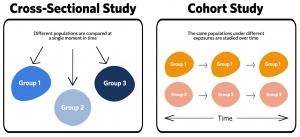Photo by 丁亦然 on Unsplash
By Sila Rogan and Elyse Tsang
What is quantitative research?
Numbers are the hallmark of quantitative research. Quantitative research is characterized by collecting and analyzing numerical data generated through various statistical, computational, or mathematical methods. These quantitative findings can determine associations or causality between variables and can also be used to draw inferences about a wider population [1]. Broadly speaking, quantitative research design is categorized as descriptive or experimental.
Descriptive quantitative research
The purpose of descriptive study is to describe a population through its characteristics, trends, and frequencies to name a few factors [2]. Descriptive research involves the observation and measurement of uncontrolled variables to determine the “what” component of a research topic, rather than the “why”.
Experimental quantitative research
In experimental studies, researchers manipulate independent variables and measure their effects on dependent variables. In this way, experimental research aims to establish causality [1].
| Click here for more on descriptive and experimental quantitative research design. |
Statistical analysis
Statistical analysis is an important tool that is performed to make meaningful interpretations of quantitative data. It helps us discover trends, patterns, and relationships in our findings which ultimately enables us to draw valid conclusions from our research.
Descriptive quantitative methods
Descriptive statistics uses numerical summaries, such as central tendency, variability, and distribution, generated through various statistical tools to describe and understand a sample [3,4]. This type of quantitative analysis tends to be the most valuable in a rural health research context, as numerical summaries are useful for gathering political and public support for improving rural health services as well as developing more effective health interventions [5].
Inferential quantitative methods
Inferential statistics establishes quantitative associations between two or more variables of interest and often involves drawing conclusions from a subset of the population before generalizing them to a larger population [6].
For the most part, experimental studies and inferential statistics are not the best fit for rural health research as rural health is generally influenced by several dynamic external variables like socio-economic factors and geography which are not accounted for in an experimental setting. Furthermore, rural populations are incredibly diverse, so generalizations can be inaccurate
Application of quantitative methods in rural health research
Study designs
Cross-sectional studies
Cross-sectional studies are conducted by collecting data from a population at a single moment in time [7]. The population under investigation is selected based on inclusion and exclusion criteria according to the study’s goal. In this way, cross-sectional studies are considered descriptive as researchers do not manipulate the exposure or treatment variables. Common rural health applications for cross-sectional study design include population-based surveys and chart audits [7].
Cohort studies
Unlike cross-sectional studies, cohort studies follow a population with a defining characteristic over an extended period of time—typically for many years [8]. They are particularly effective at identifying risk factors for disease. Cohort studies may be prospective (carried out in the future) or retrospective (the examination of pre-existing data) in nature [9]. In terms of rural health, cohort studies are useful for making comparisons between rural and urban populations or comparing different rural populations to one another.

Data analysis tools
Rural health indexes
Quantitative methods can be used to generate rural health indexes. These are measurement tools based on quantitative data analysis that can function as a proxy for various features of the health of rural communities [5]. They are useful for health services planning and provide a standardized way of comparing health characteristics across diverse communities [5]. Generally, these indexes must be accompanied by some form of qualitative data to contextualize the index within all the factors that influence the health of a particular community. That is, researchers should caution against using rural health indexes as an exclusive measure to define the health of a rural community.
Examples of rural health indexes
The Rural Birth Index (RBI)
Using data on remoteness and population characteristics of rural communities, the RBI is an objective measure of need for maternity services and can theoretically be used to predict an appropriate and sustainable level of these maternity services in rural communities.
General Practice Rurality Index
This index can be used to measure how rural a physician’s practice is, and accounts for several factors including remoteness from the nearest specialist, remoteness from an advanced referral centre, and presence of an acute care hospital.
Geography-based tools
Geography has a large influence on the health of rural communities and rural health services planning. A combination of geographic and quantitative research methods can be used to develop important metrics and statistics for rural health. For example, RHSRNbc’s catchment project uses a geographic information system (ArcGIS) to map rural community catchments that are within a one-hour drive to the nearest hospital.
Considerations when using quantitative methods in a rural health research setting
- Heterogeneity between rural communities presents difficulty in generalizing findings across different rural populations.
- A small, non-homogenous sample size can make it challenging to validate statistical methods; carefully defining the population of interest can help overcome this challenge.
- Certain populations make up a greater proportion of the population in rural areas relative to urban areas. In BC, many rural communities have a greater proportion of elderly and Indigenous people. This is an important consideration when defining the population of your research project.
- Many statistical resources and methods have been developed in urban areas and are not yet tailored to a rural setting—though this is an area for further research. For instance, statistical tools such as confidence level and effect size reward larger samples.
Examples of quantitative models used in rural health studies
Check out these journal articles from the Canadian Journal of Rural Medicine to develop a firmer grasp on how quantitative models are applied within real rural health studies.
This study examining the rural-urban differences in health services utilization generated multivariate logistic regression models to represent their findings and used Chi-square tests in their data analyses.
In this study, a Bland-Altman plot is used to map the correlation between two methods of estimating intravascular volume: point-of-care ultrasound and physical examination.
Assessment of rural emergency department physician staff, hiring practices and needs (2021)
The methods in this study involved a survey quantifying the number of rurally practicing physicians and their level of qualification in rural hospitals across Ontario’s Champlain Local Health Integration Network.
How has your research team used quantitative methods in your study design? Let us know in the comments!
Contact us at rhsrn.bc@ubc.ca or find us on Twitter @RHSRNbc.
Sources
[1] Ware S. LibGuides: Quantitative Research and Analysis: Quantitative Methods Overview n.d. https://lib-guides.letu.edu/quantresearch/quantmethods (accessed June 28, 2021).
[2] Descriptive Research Design | Definition, Methods and Examples. Scribbr 2019. https://www.scribbr.com/methodology/descriptive-research/ (accessed June 29, 2021).
[3] Descriptive Statistics – an overview | ScienceDirect Topics n.d. https://www-sciencedirect-com.ezproxy.library.ubc.ca/topics/mathematics/descriptive-statistics (accessed June 16, 2021).
[4] Difference between Descriptive and Inferential Statistics. Statistics By Jim 2018. http://statisticsbyjim.com/basics/descriptive-inferential-statistics/ (accessed June 28, 2021).
[5] RRH: Rural and Remote Health article: 426 – The planning of rural health research: rurality and rural population issues n.d. https://www.rrh.org.au/journal/article/426/ (accessed June 16, 2021).
[6] Inferential Statistics – an overview | ScienceDirect Topics n.d. https://www-sciencedirect-com.ezproxy.library.ubc.ca/topics/medicine-and-dentistry/inferential-statistics (accessed June 16, 2021).
[7] Methodology Series Module 3: Cross-sectional Studies n.d. https://www.ncbi.nlm.nih.gov/pmc/articles/PMC4885177/ (accessed July 5, 2021).
[8] Barrett D, Noble H. What are cohort studies? Evidence-Based Nursing 2019;22:95–6. https://doi.org/10.1136/ebnurs-2019-103183.
[9] Cohort study: Finding causes, examples, and limitations n.d. https://www.medicalnewstoday.com/articles/281703 (accessed July 5, 2021).



preeti zaveri
March 22, 2023 — 2:06 am
Amazing content! this is my Research paper example blog please checkout once